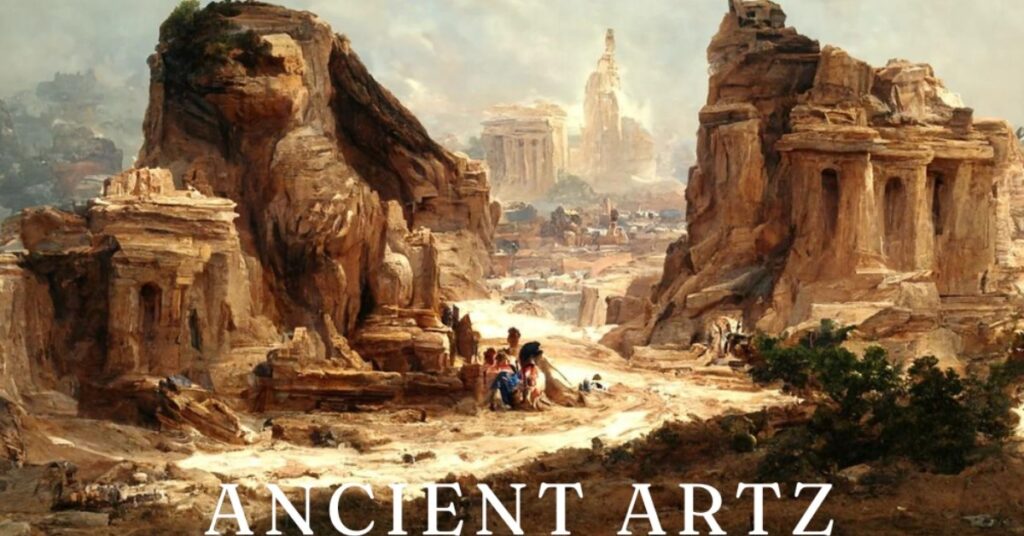Ancient artz encompasses the artistic creations of early human civilizations, spanning thousands of years and reflecting a wide range of mediums and styles. From the enigmatic cave drawings of prehistoric peoples to the sophisticated sculptures of ancient Greece and Rome, these artworks offer invaluable insights into our ancestors’ lives, beliefs, and societal structures. This article delves into the diverse manifestations of ancient artz, tracing its evolution and highlighting its significance in understanding the early human experience.
The Dawn of Art: Prehistoric Cave Paintings
The Origins of Artistic Expression
The earliest known examples of human art are the cave paintings found in various parts of the world. These artworks, dating back to the Upper Paleolithic period (approximately 40,000–10,000 BCE), provide a glimpse into the lives and beliefs of early humans. The most famous of these is the Lascaux cave system in France, renowned for its intricate depictions of animals such as horses, bison, and deer. These paintings are believed to have been created using natural pigments and were likely intended for ritualistic or symbolic purposes.
Significance and Interpretation
The cave paintings of Lascaux and other sites like Altamira in Spain reveal that early humans had a sophisticated understanding of their environment. The dynamic and detailed representations of animals suggest a deep connection with the natural world, possibly reflecting hunting practices, spiritual beliefs, or storytelling traditions. These artworks are not merely aesthetic but also serve as a window into the cognitive and cultural development of early human societies.
The Art of Early Civilizations: Mesopotamia and Egypt
Mesopotamian Art: The Cradle of Civilization
As human societies evolved, so did their artistic expressions. In ancient Mesopotamia (circa 3500–539 BCE), art played a crucial role in religious and political life. The Sumerians, Akkadians, Babylonians, and Assyrians all contributed to a rich tradition of art characterized by detailed sculptures, cylinder seals, and intricate bas-reliefs.
The Stele of Hammurabi, a basalt monument inscribed with one of the earliest known legal codes, exemplifies the blend of art and governance in Mesopotamian culture. Similarly, the Ishtar Gate of Babylon, adorned with blue-glazed bricks and reliefs of lions, demonstrates the grandeur of Babylonian architecture and its role in ceremonial processes.
Egyptian Art: Eternal Impressions
Ancient Egyptian art (circa 3100 BCE–30 BCE) is distinguished by its adherence to specific conventions and symbolism. Egyptian art was deeply intertwined with religion and the afterlife, with tomb paintings, statues, and hieroglyphs designed to honor deities and ensure the deceased’s journey to the afterlife.
The iconic pyramids of Giza and the elaborate tombs of pharaohs such as Tutankhamun showcase the Egyptians’ architectural and artistic prowess. The depiction of gods, goddesses, and pharaohs in highly stylized forms—such as the seated statue of Ramses II—reflects the importance of maintaining cosmic order and divine favor.
Classical Antiquity: Greece and Rome
Greek Art: The Pursuit of Idealism
Ancient Greek art (circa 800–31 BCE) is celebrated for its pursuit of idealism and naturalism. The Greeks revolutionized artistic representation with their emphasis on proportion, balance, and anatomical accuracy. The development of classical sculpture, exemplified by works such as the Venus de Milo and the Parthenon sculptures, reflects an idealized vision of the human form and divine perfection.
Greek art also includes the intricate frescoes and pottery from the Minoan and Mycenaean civilizations, which offer insights into everyday life, religious practices, and mythological narratives. The use of mythological themes in Greek art underscores the importance of storytelling and cultural identity in ancient Greece.
Roman Art: Embracing Realism and Innovation
Roman art (circa 753 BCE–476 CE) inherited and adapted Greek artistic traditions, blending them with a focus on realism and innovation. Roman portraiture, characterized by its lifelike depiction of individuals, offers a unique glimpse into the personalities and social hierarchies of Roman society.
Roman contributions to art include the development of architectural marvels such as the Colosseum and aqueducts, which demonstrate advanced engineering and aesthetic considerations. The use of concrete and the creation of vast public spaces like forums and bathhouses highlight the Romans’ commitment to grandeur and utility.
The Legacy of Ancient Artz
Art as a Historical Record
Ancient artz serves as a historical record, providing invaluable information about the cultures, beliefs, and daily lives of early civilizations. Through the study of ancient art, historians and archaeologists can reconstruct past societies and understand the values and priorities of ancient peoples.
The Influence on Modern Art
The artistic achievements of ancient civilizations continue to influence modern art and architecture. Classical ideals of proportion and beauty, as well as the use of symbolic and narrative elements, remain central to contemporary artistic practices. The preservation and study of ancient art ensure that the legacy of these early creators endures and inspires future generations.
Conclusion
Ancient artz, spanning from prehistoric cave paintings to the sophisticated sculptures of Greece and Rome, offers a profound understanding of early human civilizations. By exploring these artistic creations, we gain insight into the lives, beliefs, and achievements of our ancestors. The legacy of ancient art continues to resonate, bridging the past with the present and enriching our appreciation of human creativity and cultural heritage.







